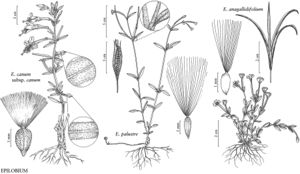Difference between revisions of "Epilobium anagallidifolium"
Encycl. 2: 376. 1786.
imported>Volume Importer |
imported>Volume Importer |
||
| Line 18: | Line 18: | ||
|rank=species | |rank=species | ||
}} | }} | ||
| − | |hierarchy=Onagraceae;Onagraceae subfam. Onagroideae;Epilobium;Epilobium sect. Epilobium;Epilobium anagallidifolium | + | |hierarchy=Onagraceae;Onagraceae subfam. Onagroideae;Onagraceae tribe Epilobieae;Epilobium;Epilobium sect. Epilobium;Epilobium anagallidifolium |
| − | |hierarchy_nav=<div class="higher-taxa"><div class="higher-taxon"><small>family</small>[[Onagraceae]]</div><div class="higher-taxon"><small>subfamily</small>[[Onagraceae subfam. Onagroideae]]</div><div class="higher-taxon"><small>genus</small>[[Epilobium]]</div><div class="higher-taxon"><small>section</small>[[Epilobium sect. Epilobium]]</div><div class="higher-taxon"><small>species</small>[[Epilobium anagallidifolium]]</div></div> | + | |hierarchy_nav=<div class="higher-taxa"><div class="higher-taxon"><small>family</small>[[Onagraceae]]</div><div class="higher-taxon"><small>subfamily</small>[[Onagraceae subfam. Onagroideae]]</div><div class="higher-taxon"><small>tribe</small>[[Onagraceae tribe Epilobieae]]</div><div class="higher-taxon"><small>genus</small>[[Epilobium]]</div><div class="higher-taxon"><small>section</small>[[Epilobium sect. Epilobium]]</div><div class="higher-taxon"><small>species</small>[[Epilobium anagallidifolium]]</div></div> |
|volume=Volume 10 | |volume=Volume 10 | ||
|mention_page= | |mention_page= | ||
| Line 58: | Line 58: | ||
|publication year=1786 | |publication year=1786 | ||
|special status= | |special status= | ||
| − | |source xml=https://xjsachs2@bitbucket.org/aafc-mbb/fna-data-curation.git/src/ | + | |source xml=https://xjsachs2@bitbucket.org/aafc-mbb/fna-data-curation.git/src/e39f0e846f172941159b2045254d62d10d9823f6/coarse_grained_fna_xml/V10/V10_326.xml |
|subfamily=Onagraceae subfam. Onagroideae | |subfamily=Onagraceae subfam. Onagroideae | ||
| + | |tribe=Onagraceae tribe Epilobieae | ||
|genus=Epilobium | |genus=Epilobium | ||
|section=Epilobium sect. Epilobium | |section=Epilobium sect. Epilobium | ||
Latest revision as of 10:32, 9 May 2022
Herbs with spreading thin, small-leafed epigeous soboles to 5 cm. Stems many, ascending, often sigmoidally bent, nodding distally, later erect, clumped or mat-forming, terete, 3–20(–25) cm, simple, subglabrous, sometimes with faint raised strigillose lines decurrent from margins of petioles, rarely mixed strigillose and sparsely glandular puberulent distally. Leaves opposite and crowded proximal to inflorescence, alternate distally, petioles 1–6 mm, rarely subsessile distally; blade spatulate to oblong proximally, elliptic to narrowly lanceolate or sublinear distally, (0.5–)0.8–2.5 × 0.3–1 cm, base attenuate to cuneate, margins subentire proximally, sparsely denticulate distally with 2–5 low teeth per side, veins obscure, 2–4 per side, apex obtuse or rounded proximally to subacute distally, surfaces subglabrous; bracts reduced, usually much narrower. Inflorescences nodding in bud, later suberect, few-flowered racemes, subglabrous to sparsely strigillose and/or glandular puberulent. Flowers suberect; buds 2–5 × 1–2 mm; pedicel 1–6(–15) mm; floral tube 0.6–1.2 × 0.8–1.8 mm, slightly raised subglabrous ring at mouth inside; sepals green to reddish purple, 1.5–5 × 0.6–1.5 mm, abaxial surface subglabrous to sparsely glandular; petals usually pink to rose-purple, rarely white, narrowly obcordate, (1.7–)2.5–6.5(–8) × 1.6–3.5 mm, apical notch 0.5–1.2 mm; filaments cream to light pink, those of longer stamens 1.4–3.2 mm, those of shorter ones 0.7–2 mm; anthers 0.3–0.6 × 0.2–0.4 mm; ovary often reddish purple, 6–20 mm, subglabrous or sparsely strigillose and glandular puberulent; style white, 1.2–2.5 mm, glabrous, stigma broadly clavate to subcapitate, entire, 0.9–1.5 × 0.4–0.7 mm, surrounded by longer anthers. Capsules slender, often reddish purple, 17–40(–55) mm, surfaces subglabrous or with scattered hairs; pedicel 5–35(–68) mm. Seeds narrowly obovoid, 0.7–1.4 × 0.3–0.5 mm, inconspicuous chalazal collar 0.1–0.2 mm wide, light brown, surface reticulate (smooth); coma persistent, dull white, 2–4 mm. 2n = 36.
Phenology: Flowering Jun–Sep.
Habitat: Moist flats, stream banks, subarctic coastal marsh edges, high montane and alpine meadows and seeps.
Elevation: 0–4500 m.
Distribution
Greenland, Alta., B.C., Nfld. and Labr., N.W.T., Nunavut, Que., Yukon, Alaska, Calif., Colo., Idaho, Maine, Mont., Nev., N.H., Oreg., Utah, Wash., Wyo., Eurasia.
Discussion
Epilobium anagallidifolium is widely but sparsely distributed in high montane-alpine and subarctic Eurasia, including Europe, Russia, China, and Japan.
Epilobium anagallidifolium usually forms low clumps or mats, with stems nodding in bud and usually subglabrous below the inflorescence. Many collections of E. anagallidifolium from eastern Canada and Greenland tend to be unusually tall (to 25 cm) and robust for the species, with somewhat larger, thicker leaves, and longer pedicels (to 60 mm). Similarly large and robust specimens occur scattered in Yukon and Washington, and may result from occasional hybridization and introgression with sympatric species such as E. hornemannii or E. lactiflorum, which also have the CC chromosomal arrangement. In an analysis of Fennoscandian populations of the Alpinae group, I. Kytövuori (1972) found a similar pattern of mostly smaller, sigmoidal plants of E. anagallidifolium with a small proportion of larger ones, and he also suggested the possibility of hybridization and/or introgression.
Plants of Epilobium anagallidifolium, and indeed of the whole Alpinae group, from Haida Gwaii (the Queen Charlotte Islands) of British Columbia (J. A. Calder and R. L. Taylor 1968), are particularly distinctive compared to those on the mainland, and difficult to interpret. The observed differences may be the result of hybridization with other sympatric species or a response to unique ecological conditions on the islands, reinforced by relative isolation from mainland British Columbia.
The Linnaean name Epilobium alpinum has long been a source of nomenclatural confusion and instability, since it circumscribed at least four distinct species, especially E. anagallidifolium. A proposal by P. C. Hoch et al. (1995) to permanently reject the name E. alpinum Linnaeus was approved.
Selected References
None.
